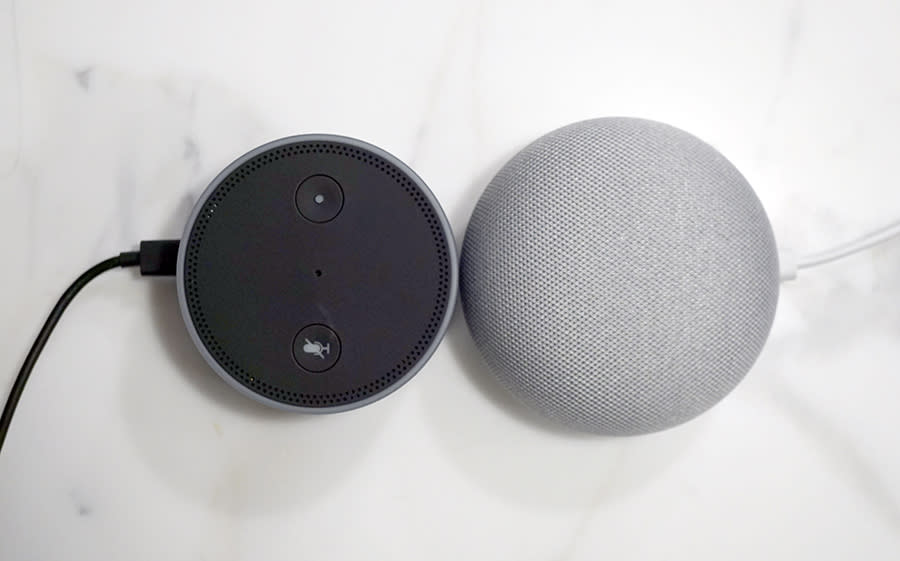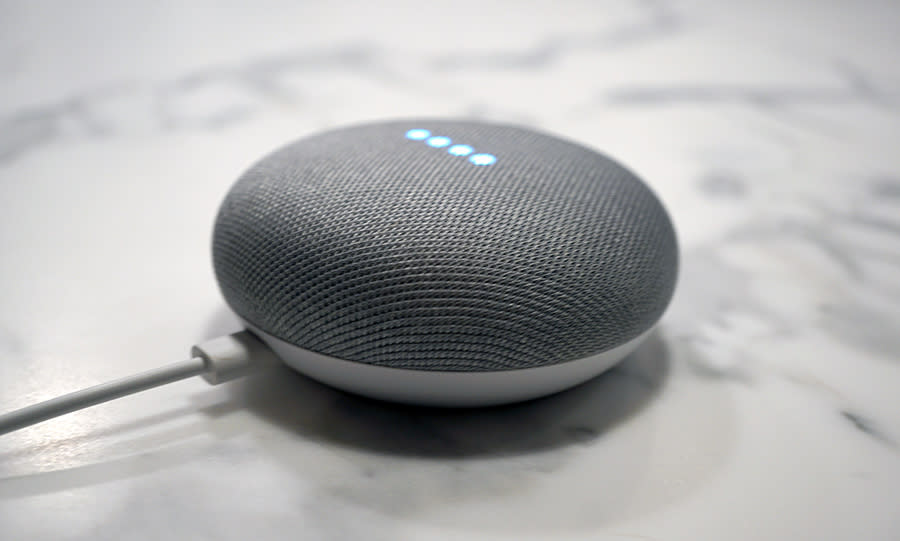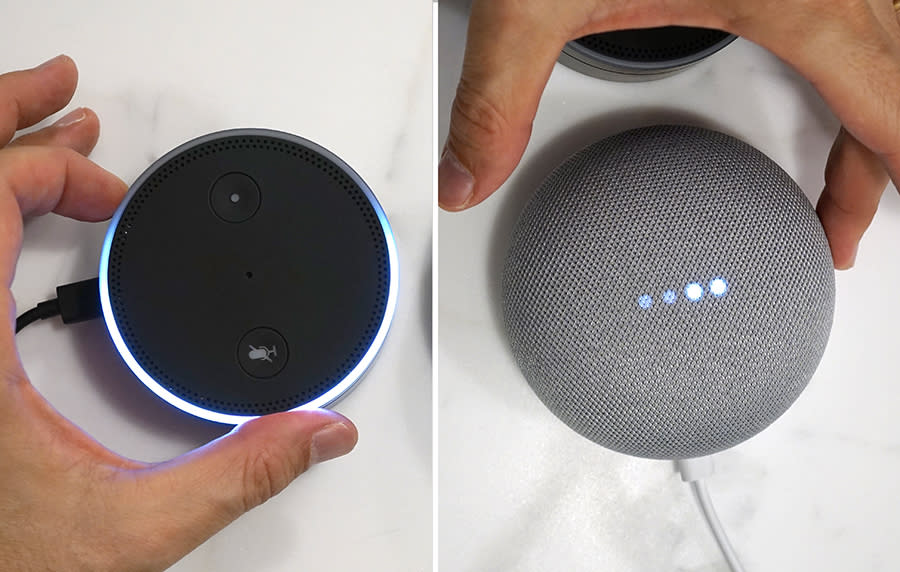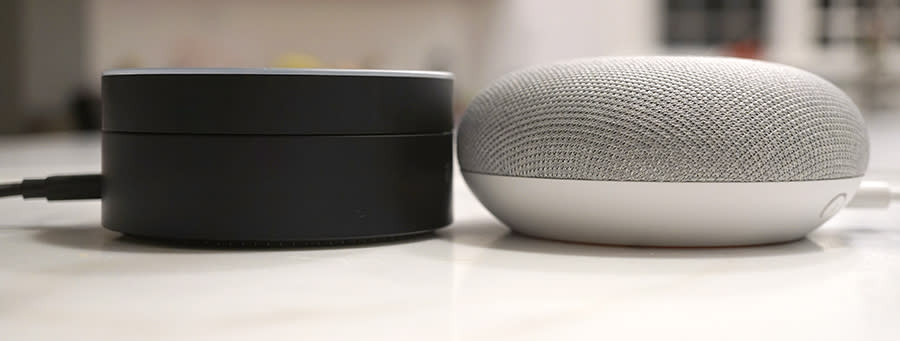The $50 Google Home Mini vs. the $50 Amazon Echo Dot—who wins?
Ever since Amazon (AMZN) created the Amazon Echo, the “Siri for the home” voice assistant, every company and its brother has rushed to come up with one almost exactly like it.
Take, for example, the Amazon Echo Dot. Like the full-size Echo, it responds to your commands and questions from across the room—but it’s a tiny, sawed-off one that costs $50. The only difference is that because you don’t have the big cylinder, the sound quality is tinny. It makes a fantastic second Echo—say, for the upstairs.
Well, now here’s Google (GOOG, GOOGL) with its own version of the Dot, called the Google Home Mini. Also puck-shaped, also $50. (Google will also be releasing the Google Home Max, a beefier version with better sound.)

The Dot and the Mini are 90% identical. They both work great. Each has a Microphone Off switch, so you can be sure that it’s not listening for its trigger word. Both can now distinguish who is making the request, so that it can respond to commands like “Play my party playlist” and “What’s next on my calendar?” with the right person’s music or info. Both now let you make free speakerphone calls to actual phone numbers (although the Google’s call quality is awful).
There are, however, a few differences to note.
In this corner: The Google Home Mini.
The sound is much better. Neither assistant pod will be mistaken for a concert hall. But there’s no question that Google’s built-in speaker is richer than Amazon’s.
It talks to Chromecasts and Android TVs. If you spring $35 for a Chromecast (a little receiver stick that plugs into a modern TV’s USB jack), or if you have a TV that runs Android TV, you can perform a nifty trick. You can say, “Ok Google, show me a video about how to remove contact lenses” or “Show me funny cat videos” or “Show me the trailer for the new Avengers movie,” and it appears on your TV instantly. As you can see in the video above, it’s quite magical.
It will someday have a tap-to-talk feature. The top of the Mini is supposed to be touch sensitive. As designed, you could tap it to issue a command (instead of saying “OK Google”), or tap it to pause music. But just as the Home Mini was shipping, a reviewer discovered a bug in which that button thought that it was being pressed all the time, transmitting everything anyone said in the room to Google’s servers. So Google responded by shutting off that top button’s features altogether.

And now, in this corner: The Amazon Echo Dot.
Works with more home-automation products, like internet-controlled thermostats, lights, security cameras, and so on. It’s a huge list. Google’s improving on this front, but Amazon’s had a several-year head start.
It has an audio output jack. Lots of people love plugging in their nice speakers or sound systems to an Echo Dot, thanks to the standard miniplug on the side (the Google offers nothing similar). That makes it easy to control your music by voice—one of the most luxurious features ever.

You can see feedback across the room. The Dot’s LED ring glows in different colors and patterns to communicate different things—for example, it glows when it’s transmitting sound back to Amazon. You can see it from the side, and therefore from across the room. The Google’s four LEDs are visible only when you’re looking down on the device, which isn’t nearly as useful.
You can order stuff. Of course, this is exactly what Amazon hopes you’ll do, but it’s still cool. “Alexa—order more paper towels.”
If you’re a Google Play subscriber, maybe the convenience of speaking your desires for music tips the balance for you toward the Google Home Mini. (The argument about “Buy a Google Home if you keep your calendar in Google Calendar” doesn’t really hold water, since the Echo can consult or add events to the calendar systems of Google or Apple (AAPL) or Microsoft (MSFT).
Otherwise, though, the Echo Dot is still the better micro-assistant. (Especially when it’s on sale for $40—for example, on the typical Black Friday, which is in a couple of weeks.)

Both of these devices are delicious enhancements to almost anyone’s home. Over time, you’ll find more and more ways that they’re useful—and for only 50 bucks!
Correction: The originally posted version of this story referred to the volume ring of the Echo Dot. That was a feature of the first-generation Dot; the current second-generation Dot has volume buttons on the top instead of the ring.
More from David Pogue:
The Fitbit Ionic doesn’t quite deserve the term ‘smartwatch’
Augmented reality? Pogue checks out 7 of the first iPhone AR apps
iOS11 is about to arrive — here’s what’s in it
MacOS High Sierra comes this fall—and brings these 23 features
T-Mobile COO: Why we make investments like free Netflix that ‘seem crazy’
How Apple’s iPhone has improved since its 2007 debut
Gulliver’s Gate is a $40 million world of miniatures in Times Square
Samsung’s Bixby voice assistant is ambitious, powerful, and half-baked
Is through-the-air charging a hoax?
David Pogue, tech columnist for Yahoo Finance, is the author of “iPhone: The Missing Manual.” He welcomes nontoxic comments in the comments section below. On the web, he’s davidpogue.com. On Twitter, he’s @pogue. On email, he’s poguester@yahoo.com. You can read all his articles here, or you can sign up to get his columns by email.

